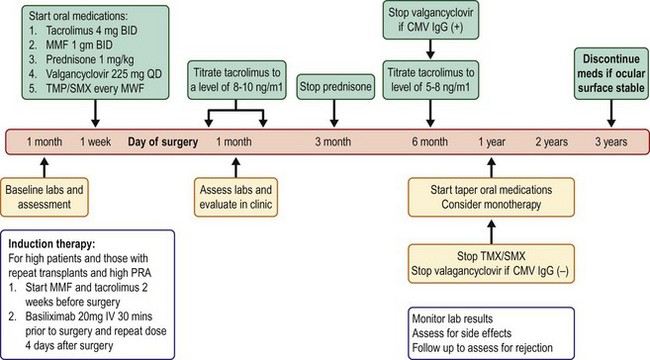Immunosuppression in Ocular Surface Stem Cell Transplantation
Introduction
Patients with bilateral limbal stem cell deficiency or severe unilateral limbal stem cell deficiency, who are not candidates for autologous transplantation alone, require allograft tissue to restore their limbal stem cell population.1,2 Limbal tissue with its greater load of Langerhans cells has a high presence of antigens, compared to clear corneal avascular tissue.3 This is relevant in living-related conjunctival limbal allograft (LR-CLAL) and in keratolimbal allograft (KLAL) where a small rim of vascular conjunctiva in addition to rich limbal tissue is transplanted directly adjacent to recipient blood vessels. In addition, eyes with severe ocular surface disease not only have a deficiency in limbal stem cells, but also suffer from chronic conjunctival inflammation (Table 46.1) which is a poor predictor for limbal stem cell transplantation success.4
Table 46.1

Patients with Stage IIb and IIc disease often have concomitant conjunctival scarring, decreased aqueous and tear production, potential for ocular surface keratinization, and have the poorest prognosis for surgical rehabilitation.1,4
(Modified from Holland EJ. Epithelial transplantation for the management of severe ocular surface disease. Trans Am Ophthalmol Soc 1996;94:677–743; and Holland EJ, Schwartz GS. The evolution of epithelial transplantation for severe ocular surface disease and a proposed classification system. Cornea 1996;15:549–556.)
In solid organ transplantation, aggressive systemic immunosuppression is understood to be crucial to the survival of the allograft and we have learned a great deal, especially from our renal transplant colleagues. Therefore, a strong emphasis must be placed on the importance of long-term multiagent systemic immunosuppression in maintaining graft survival and a clear, stable ocular surface following limbal stem cell transplantation5–7 in addition to topical therapy. In one study, 31 eyes of 23 patients with aniridic keratopathy underwent limbal stem cell replacement using KLAL from cadaver donors5 Nineteen (90.5%) of 21 eyes receiving systemic immunosuppression obtained a stable ocular surface, whereas only four (40.0%) of 10 eyes not receiving systemic immunosuppression achieved ocular surface stability (p < 0.01). Another study of 12 eyes from 10 patients who underwent KLAL with prolonged systemic immunosuppression (mean 52.7 months) improved the outcomes in eyes with total limbal stem cell deficiency.6 The largest study of 225 eyes from 136 patients after ocular surface stem cell transplantation (OSST) using a protocol of long-term systemic immunosuppression (mean 42.1 months) demonstrated a stable ocular surface in 105 (77.2%) patients.7 It should be noted that immunosuppression is necessary in all patients who receive limbal allografts, including those who receive HLA-matched living-related tissue.8
Topical Immunosuppression
Following limbal allograft transplantation, all patients begin topical immunosuppression using corticosteroids and cyclosporine at a respective four times a day and two times a day dosing. This regimen is maintained on a tapered dose of twice daily or once daily, depending on the degree of ocular surface inflammation, indefinitely. Previously, corticosteroids such as 1% prednisolone acetate and compounded 2% cyclosporine A were effective for eyes undergoing OSST. However, with the advent of 0.05% difluprednate ophthalmic emulsion (Durezol, Alcon Inc., Fort Worth, TX), a more potent steroid that has shown similar clinical results at half the dose when compared to prednisolone acetate,9 and cyclosporine 0.05% emulsion (Restasis, Allergan, Irvine, CA), these two agents used at doses of four times daily and two times daily, respectively, now represent the mainstay of topical immunosuppression regimens after allograft transplantation. In patients with controlled ocular surface inflammation and steroid-induced elevated intraocular pressures, topical loteprednol (Lotemax, Bausch and Lomb, Rochester, NY) may be used instead.
Systemic Immunosuppression
In the earlier years of using systemic immunosuppression with OSST, oral prednisone, cyclosporine (Neoral; Novartis, East Hanover, NJ), and azathioprine (Imuran; GlaxoSmithKline, Philadelphia, PA) were used. The current protocol (Fig. 46.1) now includes tacrolimus (Prograf; Astellas Pharma US, Inc, Deerfield, IL), mycophenolate mofetil (MMF, Cellcept; Hoffmann La Roche, Nutley, NJ), and a shorter course of prednisone. The use of these three medications in combination was affirmed as the mainstay of immunosuppression in renal transplantation with the ELiTE (Efficacy Limiting Toxicity Elimination)-Symphony randomized control study.10
Corticosteroids such as prednisone, prednisolone acetate, loteprednol, and difluprednate, are still the most rapid immunosuppressant available. They exert their effects by non-specifically inhibiting many aspects of the inflammatory response, including blocking the synthesis of prostaglandins and reducing the number of circulating T lymphocytes. Tacrolimus is similar to cyclosporine (both are calcineurin inhibitors that inhibit T-lymphocyte activation by binding to FK-506 and cyclophilin regulatory proteins, respectively), but the adverse effects of gingival hyperplasia and hirsutism are not seen with tacrolimus, making it more tolerable for patients.11 Azathioprine and MMF are antimetabolites that inhibit the proliferation of both T and B lymphocytes. Large clinical trials involving renal transplant patients have shown a lower incidence of acute graft rejection in patients receiving MMF versus azathioprine (when both groups received steroids and cyclosporine).12
A Steroid-Minimizing Protocol
In the current systemic immunosuppression protocol that is advocated in OSST (see Fig. 46.1), oral prednisone is initiated at a dose of 1 mg/kg/day, and the dose is tapered over 1 to 3 months, depending on the level of inflammation. Oral tacrolimus is initiated at 4 mg twice daily and oral MMF at 1 g twice daily. The dose of tacrolimus is decreased around 6 months and MMF after 12 months, depending on the degree of ocular surface inflammation and corneal epithelium stability. Patients are on 225 mg of valganciclovir (Valcyte; Hoffmann La Roche, Nutley, NJ) daily and trimethoprim/sulfamethoxazole (Bactrim, single strength; Mutual Pharmaceutical Company, Philadelphia, PA) one tablet every Monday, Wednesday, and Friday, for prophylaxis against cytomegalovirus and Pneumocystis carinii








